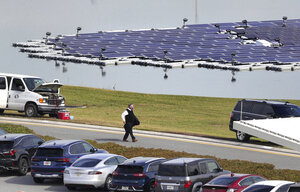Electricity’s clean giants sizzle – quietly
Worldwide, companies that generate power from renewable, nonpolluting sources are becoming major players.

A new Floating Solar Array at the Orlando (Florida) International Airport opened Dec. 10, 2020. The 19,350-square-foot island includes 360 solar panels.
AP
Five years after the groundbreaking Paris climate accord, governments still find themselves scrambling to confront the crisis. At the recently concluded Climate Ambition Summit 2020, United Nations Secretary-General António Guterres urged countries to declare themselves to be in a state of climate emergency. Nearly 40 already have.
But amid that alarm one part of the solution has been quietly underway. Companies that produce clean electricity (wind and solar power, which doesn’t result in the release of climate-warming carbon dioxide) have been growing at a spectacular rate, attracting enthusiastic investors that even include cautious pension funds.
Far from being small feel-good boutique businesses with little energy to add to the grid, these companies are emerging as clean power giants. Their origins come from both the world of electric utilities, with little-recognized names like Enel, NextEra Energy, Iberdrola, and Orsted, as well as from oil and gas behemoths such as Britain’s BP, which see that the future of energy is in renewable sources. The clean energy companies aren’t tiny upstarts: The value of NextEra stock, for example, briefly surpassed that of ExxonMobil in value last fall.
In the United States, renewable electricity from wind, solar, and hydropower already makes up nearly 18% of the total output. That’s up from almost none 10 years ago. Globally, wind and solar produce about 9% of the electricity generated, a figure that should grow to 56% by 2050, according to BloombergNEF, which researches clean energy.
A dramatic drop in the cost of solar panels and wind turbines is making clean energy more and more cost competitive, even against abundant natural gas, and is restructuring the energy marketplace. Spending on renewable electrical power may for the first time exceed spending on oil and gas drilling, predicts Goldman Sachs.
In his campaign, U.S. President-elect Joe Biden promised to look much more kindly on clean energy efforts. A newly formed renewable energy trade group, the American Clean Power Association, with some 800 member companies, officially debuts Jan. 1, and will try to hold him to his promises.
Around the world new records for the generation of clean energy are being set. In October, the Australian state of South Australia, with its 1.76 million people, briefly was powered by solar energy alone. Solar now consistently provides about half the state’s electrical needs.
Because solar and wind provide variable levels of output (periods of lack of sunlight or wind), how to store electricity has presented a challenge. That’s why a recent report from Wood Mackenzie and the Energy Storage Association is so encouraging. It shows that some 476 megawatts of storage was deployed in the U.S. in the third quarter of 2020, an increase of 240% from the previous high, set in the second quarter.
Numbers and stats can overwhelm. But their message is clear: The conversion to a world powered by electricity from renewable, nonpolluting sources is underway. Clean energy still faces challenges. But incubated by government incentives, private efforts have grown up, changing the way we light our lives and helping to slow the warming of our planet.

